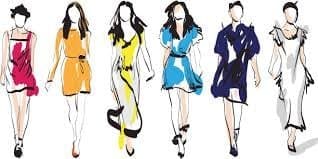Design brain research, is the investigation and treatment of how shading, picture, style and magnificence influences human conduct, while tending to social standards and social sensitivities.
It centres rises above dress to likewise consider the effect of numerous different items that communicate character and are impacted by similar powers that drive change in the clothing business, for example, home goods, beauty care products, and even autos.

Design brain science is essential to advertisers who need to comprehend the elements that make it likely an item will be embraced by a gathering of buyers, and who need to foresee how long that item will keep on remaining in style. In this way, some portion of style brain science centers around changes in acknowledgment after some time. For instance, a great is a design with an amazingly long acknowledgment cycle that is received by a genuinely enormous gathering. Interestingly, a trend is a fleeting style. Moderately scarcely any individuals embrace a prevailing fashion item, however it can spread rapidly. Adopters may all have a place with a typical subculture, and the craze “streams over” individuals however once in a while breaks out of that particular gathering.
Numerous mental elements help disclose what spurs us to be in vogue. These incorporate similarities, wants for assortment chasing, the need to communicate individual innovativeness, and sexual fascination. For instance, numerous customers appear to have a requirement for uniqueness: They need to appear as something else (however not really excessively extraordinary!). Subsequently, individuals may adjust to the essential blueprints of a design, yet ad lib to offer an individual expression inside these overall rules.
Various examinations have taken a gander at how varieties in attire impact onlookers’ reactions. For instance, one investigation found that men would in general leave higher tips for servers who wore red tops. The “dress for progress” marvel shows the boundless conviction that appearance legitimately impacts the manner in which individuals are dealt with.

When youngsters arrive at their teenagers, a formative stage when they’re normally unreliable and looking for an individual personality, they’ve been encouraged that material belongings are what matter. Promoters comprehend the youngster’s longing to be “cool,” and control it to sell their products, an idea that has been offered to advertisers by analysts including James McNeal, PhD, who stated “Children as Customers: A Handbook of Marketing to Children,” distributed in 1992 by Lexington Books.
Youngsters need to relate to their friend gathering and from a specific perspective, that is a weakness. In reality, youngsters and tweens, kids between the ages of 12 and 14, are pulled in to the renown they accept brand-name dress gives them. The fascination in esteem brands creates in young adult years since it’s when friend weight and fitting in are significant.
What your identity is incorporates how you satisfy your sexual orientation job, which with the force of showcasing to teenagers, can’t resist the urge to be characterized by items and pictures. Albeit harming to both genders – men frequently experience strain to glance and carry on in hyper-manly ways that impact personality – young ladies bear an especially high weight of extreme publicizing.

Consistent introduction to advertisements promising the world- – excellence, fame, genuine feelings of serenity, fearlessness, incredible connections – transforms numerous little youngsters into voracious customers.
Numerous adolescents are feeling the weight. Numerous adolescents accept that they are impenetrable to showcasing control. Urged to look outside of themselves for solace, qualities and heading, young ladies become simple prey to addictive practices and ridiculous pictures that advertisements advance.
– by Anushka Dwivedi
picture credits-(google images)
References:
- https://www.apa.org/monitor/jun04/driving
2. https://www.michaelsolomon.com/fashion-psychology/
Follow Social Media to get Regular updates , Account details :
-
- Facebook : fashionvaluechain
- Instagram : fashionvaluechain
- Pinterest: fashionvaluechain
- Linkedin : fashionvaluechain
- twitter : fvcmedia

